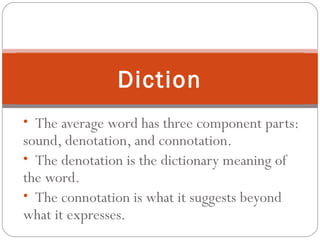
Diction
- 1. • The average word has three component parts: sound, denotation, and connotation. • The denotation is the dictionary meaning of the word. • The connotation is what it suggests beyond what it expresses. Diction
- 2. Connotative meaning of a word acquires its past history and associations, by the way and the circumstances in which it has been used. The word “home,” for instance, by denotation means only a place where one lives, but by connotation it suggests security, love, comfort, and family. Connotation, then, is very important to the poet, for it is one of the means by which he/she can concentrate or enrich the meaning of the poem– say more in fewer words.
- 3. Now let’s consider the following poem: There Is No Frigate Like a Book The is no frigate like a Book To take us lands away, Nor any coursers like a page Of prancing poetry. This traverse may the poorest take Without oppress of toil; How frugal is the chariot That bears a human soul! Emily Dickenson (1830-1886)
- 4. The poem deals with the great power of the book or of poetry to carry us away, to let us escape from our immediate surroundings into the world of imagination. The book is compared to various means of transportation: a boat (frigate), a team of horses (coursers), and a chariot. These vehicles take man to different places to see the wide world, life, and people. The book is a source of knowledge, a key to a door that opens to the world, thus enabling the reader to widen his/her knowledge and deepen his/her understanding. Reading a book is like travelling throughout the world. However, the book is superior to other means because the book is the most economical way for us to acquire knowledge; even the poorest can afford to travel without having to work hard to earn enough money for travelling expenses.
- 5. In making these comparisons, Dickenson is particularly careful in choosing words that have romantic connotations: “Frigate” suggests exploration and adventure, “Coursers” conveys the meaning of beauty, spirit (energetic and liveliness) and speed, “chariot” connotes the ideas of speed and the ability to go through the air as well as on land. Source: Surapeepan Chatraporn, Poetry: An Introductory Study, 1996: p. 29-30).
- 6. In making these comparisons, Dickenson is particularly careful in choosing words that have romantic connotations: “Frigate” suggests exploration and adventure, “Coursers” conveys the meaning of beauty, spirit (energetic and liveliness) and speed, “chariot” connotes the ideas of speed and the ability to go through the air as well as on land. Source: Surapeepan Chatraporn, Poetry: An Introductory Study, 1996: p. 29-30).
